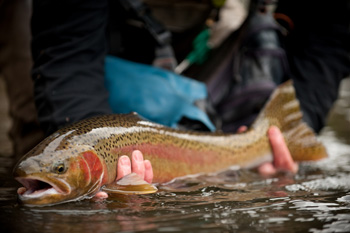Fly Fishing Jazz: How Deep is the Ocean?

Steelhead on the swing. Photo by Tim Romano
I’ll borrow from this jazz standard, best covered by Billie Holliday and Charlie Parker, to make a very important point about fly fishing, especially fly fishing with nymphs and wet flies. The depth at which your flies float through the presentation zone matters at least 10 times more than the subtleties of the fly patterns you fish.
As such, I will change my weight, when nymph fishing, at least five times before I even think about changing the bug. Having scuba dived with trout in rivers many times, and having watched as my friends cast flies at those fish, I can tell you that if you “hit the fish in the head,” they are likely to eat the fly. Whether or not the angler will be able to detect the bite is another discussion entirely. (I also noticed through the diving mask that the best nymph fishers still miss about 60 percent of strikes, as trout inhale and reject bugs with impressive efficiency.)
Depth is also a critical factor when you’re swinging flies in the traditional style for species like Atlantic salmon and steelhead. I watched two anglers fish the same steelhead run not long ago—both used the same fly (Muddler), and both cast with equal efficiency, covering and quartering as they worked. The one difference: Angler one (who caught a fish) used an intermediate sinking line, and Angler two (who did not catch any) used a floating line. Was the subtle sink factor the differentiator? There’s obviously no way to know for sure, but I suspect it was. That, and dumb luck.
You’d be surprised how much your luck can change, however, if you pay more attention to depth as you fish. In my nymph fishing experience, I’ve found that being deep enough to have your weight occasionally ticking along the bottom (without hanging up) is the best position. But being stuck in the same depth zone is like playing music in one octave—you want to go up, and down, and explore different depths as you fish runs. Doing so will make your playing (and catching) far more interesting and productive.











